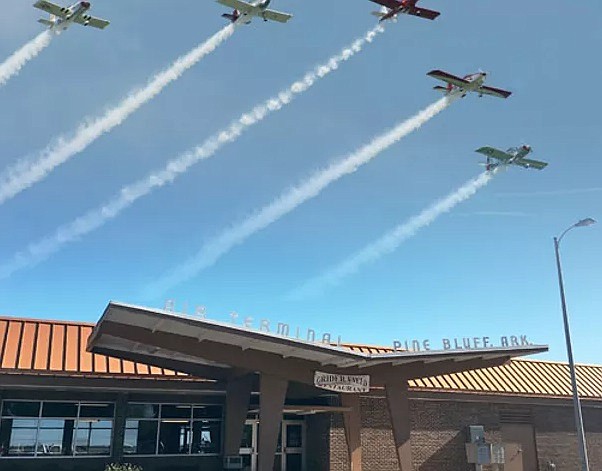The airfield known as Pine Bluff Regional Airport got its start 80 years ago during World War II. How much do you know about Grider Field and its rich military history?
March 22, 1941, is a big day in Pine Bluff aviation history. That's the day when Pine Bluff School of Aviation, as it was originally known, was opened as a U.S. Army Air Corps detachment during World War II. Named in honor of World War I pilot John McGavock Grider, the airfield encompasses approximately 850 acres located 5 miles southeast of Pine Bluff off Highway 65 South.
The story of Grider Field begins in 1940, after new regulations adopted by the Civil Aviation Authority had made Pine Bluff's first airfield, Toney Field, obsolete. With war raging across Europe and Japanese militarism rising in the Pacific, the Army Air Corps planned to arrange contracts with private flying schools to conduct primary flight training for the fledgling Army Air Corps pilots. The new airfield slated for Pine Bluff would serve this purpose.
Construction began in late November with a combination of $200,000 in municipal bond money and a $107,320 grant from President Franklin D. Roosevelt's Depression-era Works Progress Administration. In just over four months, a cotton field was prepared for an airfield, along with construction of administrative buildings, hangars, barracks, a mess hall, and a control tower, which allowed the facility to accommodate up to 150 cadets for training. The original training fleet consisted of six Fairchild PT-19 single prop, two-seated aircraft.
On March 22, 1941, under control of the United States Army Air Corps, Grider Field received its first class of 50 cadets scheduled for 10 weeks of flight instruction. The training school at the airfield increased its fleet to 275 aircraft, admitted around 12,000 pilot trainees, and graduated approximately 9,000 pilots during its three-and-a-half years of operation. At one time, 275 aircraft were being used to train 758 prospective pilots.
After the end of World War II, the airfield was returned to the City of Pine Bluff by the Civilian Aeronautics Authority in 1947. The city operated the airfield until 1957, when the Pine Bluff Aviation Commission was established to manage and maintain the airfield as a general aviation airport for southeast Arkansas.
Today, Grider Field is home to a terminal, restaurant, a growing aviation museum, a Federal Aviation Administration weather monitoring station, private corporate jet hangars, fire station, and T-hangars. Corporate users of the airport include Tyson Foods, Jefferson Regional Medical Facility, International Paper Co., the Pine Bluff Arsenal, the Arkansas Department of Correction, and the Union Pacific Railroad.
Little Rock Air Force Base in Jacksonville uses the runway, though rarely, for C-130 aircraft training, and the FAA has trained some pilots at the airport.
How much of the original facility can still be seen? As of 2020, four of the five original round-topped hangers still stand. Only one of the aviation school's original barracks remains. It is being restored to its World War II-era condition using historical records, oral history and authentic materials. When restoration is complete, the structure will become a museum that will house a growing collection of aviation artifacts and memorabilia.
A highlight of Pine Bluff Regional Airport's annual calendar is "Operation Skyhook," a fly-in sponsored by Black Pilots of America Inc. Every Memorial Day weekend, member chapters arrive for a few days of fun, aviation camaraderie and flying competition. Most of the participants own their aircraft and take great pride in showing off their most prized possessions. Generous BPA Inc. members volunteer to give airplane rides – "Young Eagle flights" – to hundreds of enthusiastic kids from the surrounding area.
This article is among features at ExplorePineBluff.com, a program of the Pine Bluff Advertising and Promotion Commission. Sources: EncyclopediaofArkansas.net, PBF-Airport.com.

